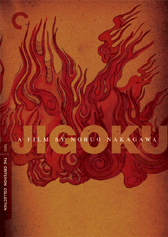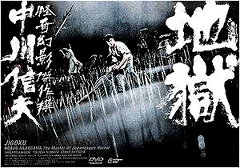
Jigoku
Directed by:
Horror / Drama, 101 minutes
Distributed by: Criterion Collection
Story:
Theology student Shiro [Shigeru Amachi] is tormented by the fact that he and his friend Tamura [Yoichi Numata] accidentally killed a man in a hit and run accident one night. His life turns to the worse when one freak accident after another kills off all the people around him until he himself passes over to the other side, Hell, where all sinners get there final punishment for all eternity.
Me:
Nabou Nakagawa’s Jigoku is one of those movies that you have to see to believe. It is probably the most extreme Kaidan movie of the early sixties and seventies, and I’d even go as far to claim that Jigoku could be the first splatter/gore movie as it was shot three years before Herschell Gordon Lewis’ landmark Blood Feast 1963 that often takes credit for starting the splatter movie genre. Jigoku has a fair share of severed hands, rivers of blood and gory mutilated corpses. Nakagawa was no stranger to the Kaidan genre as Jigoku was in fact the last of a string of nine very atmospherically and stylish genre movies that he had directed. Neither was the genre new either, as early as 1912 Shozo Makino directed the earliest version of Yotusya Kaidan [Yotsuya Ghost Story], also re-made in it’s finest version in 1959 by Nakagawa. The photography is stunning and considering the tight budget that this Shintoho Company production had it’s an amazing piece of cinema. Focusing on the Shiro we follow him though a very painful journey, his tormentor, the enigmatic Tamura who pops up when Shiro expects him the least, to poke fun at Shiro or provoke those around him. At a dinner with Shiro’s mother and father in law, when Shiro escapes to his home village to comfort his father after the death of his mother Tamura soon shows up. It’s Tamura who is in the car with Shiro as they run over
 the Yakuza man leaving him dead in the middle of the road, and this is the marker for Shiro's decent into the terrifying spiral that lands him in the dark pits of hell. There are many story lines running at the same time, there’s the sudden death of Shiro’s fiancé Yukkio [Utako Mitsuya] and the way Shiro’s relationship with her devastated parents evolves, then there’s the family of “Tiger” Kyoichi’s family planning and attempting to take their revenge for the hit and run accident, and the complex story of Shiro’s return to his home village where he meets neighbour girl Sachiko who is the double of his late fiancé, also played by Mitsuya in a double role. The acting is top notch Shigery Amachi and Yoichi Numata deliver memorable performances as the strangely linked Shiro and Tamura, and Mitsuya is very persuasive in her portrayal of Yukkio/Sachiko. Nakagawa’s works being an influence on later genre directors like Takashi Shimizu, Kiyoshi Kurosawa and Hideo Nakata is clearly noted as the tone of the movie is reminiscent of their works. It moves from a slow explanatory build up and works delicately up to the last climactic third in a manner that we are accustomed to with the later years wave of Asian horror flicks, slowly but surely.
the Yakuza man leaving him dead in the middle of the road, and this is the marker for Shiro's decent into the terrifying spiral that lands him in the dark pits of hell. There are many story lines running at the same time, there’s the sudden death of Shiro’s fiancé Yukkio [Utako Mitsuya] and the way Shiro’s relationship with her devastated parents evolves, then there’s the family of “Tiger” Kyoichi’s family planning and attempting to take their revenge for the hit and run accident, and the complex story of Shiro’s return to his home village where he meets neighbour girl Sachiko who is the double of his late fiancé, also played by Mitsuya in a double role. The acting is top notch Shigery Amachi and Yoichi Numata deliver memorable performances as the strangely linked Shiro and Tamura, and Mitsuya is very persuasive in her portrayal of Yukkio/Sachiko. Nakagawa’s works being an influence on later genre directors like Takashi Shimizu, Kiyoshi Kurosawa and Hideo Nakata is clearly noted as the tone of the movie is reminiscent of their works. It moves from a slow explanatory build up and works delicately up to the last climactic third in a manner that we are accustomed to with the later years wave of Asian horror flicks, slowly but surely. After re-watching this movie, now in the stunning presentation Criterion have released, I realised during the opening montage, that there’s a lot of similarities to Adrian Lynne’s Jacob’s Ladder going on here. Not that I know if Lynne ever saw Jigoku, but it plays with the same themes, a dead man re-living his own personal hell. I’m sure that the opening sequence is an indicator that Shiro actually is already dead when the movie starts, and the entire movie is in fact his time in hell. Compared to the previously released, long out of print, Beam Entertainment DVD from Japan, I can't really say that there's much differance to the print more than some obvious reapairs that have been made to it, also the colours look better with the remastered Criterion editon. On the other hand the Beam edition has 2.0 sound where as Criterion have opted for 1.0 mono. The extras are the big bonus with the Criterion version. Definitely a must see movie for fans of the recent wave of Japanese horror movies.
Image:
2.35:1 Anamorphic Widescreen, Colour, shot in 35mm Shintohoscope
Dolby Digital Mono 1.0
Once again Criterion gives reason to buy this disc with the extra features. This time they have included an almost forty minute documentary called Building the Inferno which focuses on the movies of Nakagawa. Actor Yoichi Numata, screenwriter Ichiro Miyagawa, Nakagawa collaborators Chiho Katsura and Kensuke Suzuki, and director Kiyoshi Kurosawa all talk about Jigoku and the influence it had on them. Just this documentary is worth the price if you want to know more about the masterful movies of Nobou Nakagawa. An essay by Chuck Stephens, and two artwork galleries stills and posters. To round it all off there’s the theatrical trailer for Jigoku.





No comments:
Post a Comment